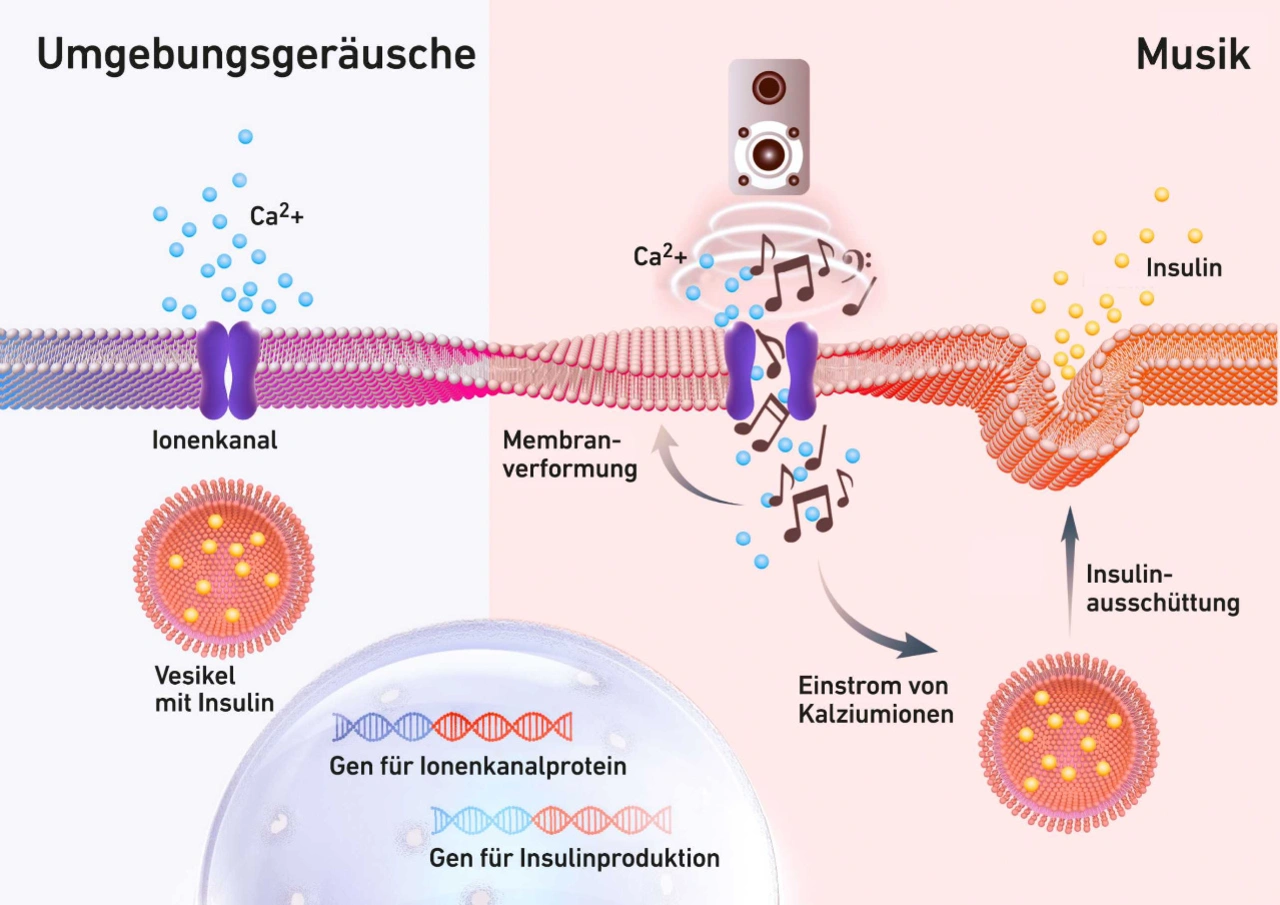Queen's Basses Produce Insulin
Diabetes can be Treated with Music
Swiss researchers have developed a gene switch. Implanted cells react to direct sound waves and release insulin. The bass boom of Queen's »We will rock you« works particularly well. The goal is to use the mechanism to produce diabetes implants.
The bodies of people suffering from diabetes produce no or too little insulin - diabetics have to administer the messenger substance externally via syringe or pump. Biosystems researchers at ETH Zurich are looking for solutions in Basel to produce and administer insulin directly in the body.
The researchers are pursuing an approach in which insulin-producing synthetic cells are enclosed in capsules and implanted in the body. To externally control when and to what extent this messenger is released from the cells into the blood, various trigger mechanisms have been studied and used in recent years - including light, temperature and electric fields.
Now scientists have presented a novel stimulation method: Music, can initiate insulin release in cells in a short time. Surprisingly, the song »We will rock you« by the British rock band Queen shows particularly high effectiveness in this process.
Cells Respond to Sound Waves
In order for the cells to produce insulin under sound waves, the scientists used a protein from the bacterium E. coli. This protein, which responds to mechanical stimuli, is common in both the animal kingdom and bacteria. Naturally, this protein is located in the membrane of the bacterium and controls the influx of calcium ions into the cell interior. The researchers integrated the construct of this bacterial ion channel into insulin-producing human cells. This allows the cells to synthesize the ion channel themselves and integrate it into their membrane.
As the researchers noted, the channel in these modified cells responds to sound waves, causing positively charged calcium ions to enter the cell. This results in a reversal of the charge at the cell membrane. As a result, small insulin-containing vesicles inside the cell fuse with the cell membrane and release the insulin to the outside.
Basses Induce Cells to Release Insulin
The scientists analyzed in cell cultures which frequencies and volume levels most influenced the ion channels. They found that volume levels around 60 decibels (dB) and bass frequencies at 50 hertz produced the most effective responses in the ion channels. For optimal insulin release, sound or music exposure should last at least three seconds, and pauses should be no longer than five seconds. Longer breaks in sound exposure significantly reduced insulin release.
Later in the study, the researchers tested which music genres produced the most intense insulin response at a volume of 85 dB. Rock music with low bass frequencies, the Queen song »We will rock you« produced the best results, followed closely by the soundtrack from the action movie »Avengers«. The response to classical music or guitar sounds, on the other hand, was comparatively low.

Insulin Requirement of an Adult is Covered
The Queen song caused a release of about 70 percent of insulin within five minutes and complete release within 15 minutes. According to the ETH researchers, this corresponds to the glucose-induced natural insulin response of healthy adults.
Cells must be directly exposed to sound
However, the result could only be achieved when the mice sat directly on a loudspeaker. If the mice were left on a kind of dance floor, the music did not release insulin. The modified cells only responded when the right music was played directly on the skin above the implant. Everyday noises such as airplane noise, lawn mower sounds, fire department sirens or conversations did not trigger an insulin response.
Implant could make everyday life easier for diabetics
Based on the tests conducted on cell cultures and mice, the research group believes there is a low risk that implanted cells would constantly produce insulin due to background noise. Another safety feature, they say, is that insulin stores would not be fully replenished for four hours after depletion. This prevents excessive insulin release from causing a dangerous drop in blood glucose levels. The system could thus cover the average needs of a diabetic who eats three meals a day. The insulin in the vesicles remains stable over a longer period of time, even if the person does not eat for more than four hours.
| »There is no degradation or unintentional discharge taking place.« |
|---|
| Martin Fussegger, Professor at ETH Zurich in Basel. |
However, a medical device based on the method, which could significantly simplify the daily lives of diabetics, is not yet within reach. The scientists have shown, however, that genetic networks can be controlled by mechanical stimuli such as sound waves. Whether this method is ever commercialized depends on the interest of a pharmaceutical company. The system is versatile and could work not only with insulin but also with other therapeutically relevant proteins. (uh)





